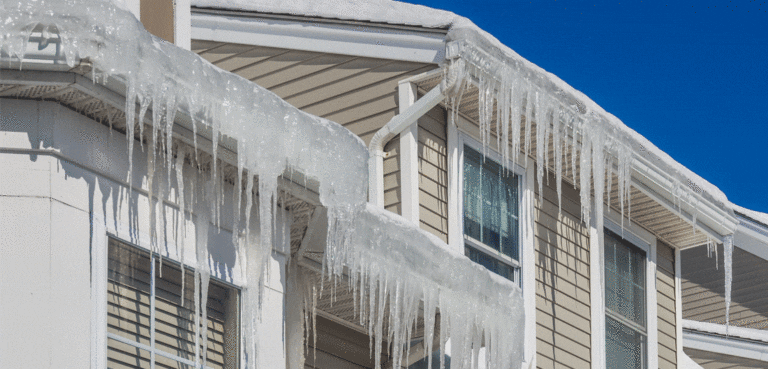What to Know About Ice Dams

Icicles are hanging from the roof, the ground is slick beneath your feet and you can spot snow, ice and debris above your head. The telltale signs are all there: You have an ice dam.
What is an Ice Dam?
An ice dam is a ridge of ice that occurs on the edge of the roof of your house that prevents melting snow from draining off your home’s roof.
Ice dams are caused by a combination of snow, heat loss from your house and cold outdoor temperatures.
When warm air escapes from your home, melts the snow on your roof surface and then refreezes on your roof’s edge it prevents proper run off. The more snow and colder temperatures, the greater the chances you have of ice dams forming on your eaves. And as more snow melts, the dam continues to grow. In particularly nasty weather conditions like ice storms, ice dams can form quickly, so it’s best to have a plan for dealing with them.
Do You Need to Remove an Ice Dam?
The short answer, of course, is to remove the ice dam. Although icicles might look pretty, an ice dam is simply too dangerous to be ignored. If left unattended they can cause leaks in your home, damage your gutters or both. Breaking off the icicles themselves won’t help prevent ice damming – and the pieces of sharp ice could be dangerous as they fall.
Before you remove an ice dam, you first must determine whether you will tackle the task yourself or hire a professional. Here’s what to consider when it comes to both options.
How Do You Get Rid of an Ice Dam Yourself?
It may seem counter intuitive, but the best way to remove an ice dam is to first focus on the snow. Ice dams require specific conditions to form, and the snow on your roof’s surface supports these conditions by acting as an insulator.
Start the ice-dam-removal process by using a long-handled aluminum roof rake to pull snow from your roof to the ground. Use the telescopic roof rake, found at most hardware stores, and try to remove the three to four feet of snow closest to the edge of your roof.
Once you’ve removed the snow, you’ll see the ice formation underneath. Use a ladder to reach this area and apply an ice melt product like calcium chloride. If you don’t have a ladder or you’re not interested in climbing one, you can also use throwable ice-melt solutions. These products, which are the size of small plates, are specifically designed to be thrown up on the roof to melt ice in hard-to-reach places. The calcium chloride will melt the snow and ice, allowing water to flow off the roof and gutters.
Applying an ice-melt product is the safest, most efficient way to remove an ice dam from your home. Avoid the temptation for a dramatic quick fix, like melting the ice with fire or chipping at the ice with an axe, pick, screwdriver or similar object. Doing so will only expose you to injury and your home to damage.
Do You Need to Hire a Professional to Remove Your Ice Dam?
If you’d feel better leaving your ice dam-removal project to the experts, head online to hire a contractor in your area. (Read our list of tips for how to hire a contractor.) Look for one who will remove the ice dam using low-pressure steam as opposed to high-pressure washing, which can damage your roof. The process of warming the roof will melt the ice dam and snow that is causing the problem.
Low-pressure steam may be expensive. But if you’re okay with the higher cost, hiring a professional will spare you from having to tackle one of winter’s most notorious weather issues yourself.
How Do You Prevent Ice Dams?
Short-term, you need to remove any existing ice dams to prevent further damage. Long-term, you need to look for the cause and prevention. This is often easier to do before the snow starts falling.
While you’re using some of our nifty tricks to keep the cold air out of your house this winter, there are also important steps you can take to keep the warm air in. Since ice dams are caused by uneven temperatures, you can prevent them by working to keep your roof temperatures consistent.
Poor insulation can contribute to heat loss. It is important to check your attic space and see if you need to add insulation in your attic floor. The older your home, the more likely additional insulation is needed, but don’t assume because you have a newer home you don’t need to check. Start by taking a quick look at your attic. If you find the insulation is level with or below the floor joists, you need to add more. You attic insulation should be continuous and lay at a consistent depth.
Increasing ventilation is another way to prevent ice dams. This can be accomplished by roof ridge and soffit vents. A ridge vent paired with continuous soffit vents circulates cold air under the entire roof keeping steady temperatures.
Look for other ways warm air may be escaping. Recessed lights, skylights, complicated roof designs, chimneys, bathroom exhaust fans and heating ducts in the attic can all increase the risk of ice dam formation.
Prevention and Protection
Managing ice during the colder months can be tricky, and a well-thought-out prevention plan can make the snowy season a little less daunting. Likewise, making sure you’re protected against winter’s plentiful pitfalls can provide peace of mind.
A great way to protect your home during winter is by having the right homeowners insurance. To find out which coverages you need, contact us today.
ERIE® insurance products and services are provided by one or more of the following insurers: Erie Insurance Exchange, Erie Insurance Company, Erie Insurance Property & Casualty Company, Flagship City Insurance Company and Erie Family Life Insurance Company (home offices: Erie, Pennsylvania) or Erie Insurance Company of New York (home office: Rochester, New York). The companies within the Erie Insurance Group are not licensed to operate in all states. Refer to the company licensure and states of operation information.
The insurance products and rates, if applicable, described in this blog are in effect as of July 2022 and may be changed at any time.
Insurance products are subject to terms, conditions and exclusions not described in this blog. The policy contains the specific details of the coverages, terms, conditions and exclusions.
The insurance products and services described in this blog are not offered in all states. ERIE life insurance and annuity products are not available in New York. ERIE Medicare supplement products are not available in the District of Columbia or New York. ERIE long term care products are not available in the District of Columbia and New York.
Eligibility will be determined at the time of application based upon applicable underwriting guidelines and rules in effect at that time.
Your ERIE agent can offer you practical guidance and answer questions you may have before you buy.


